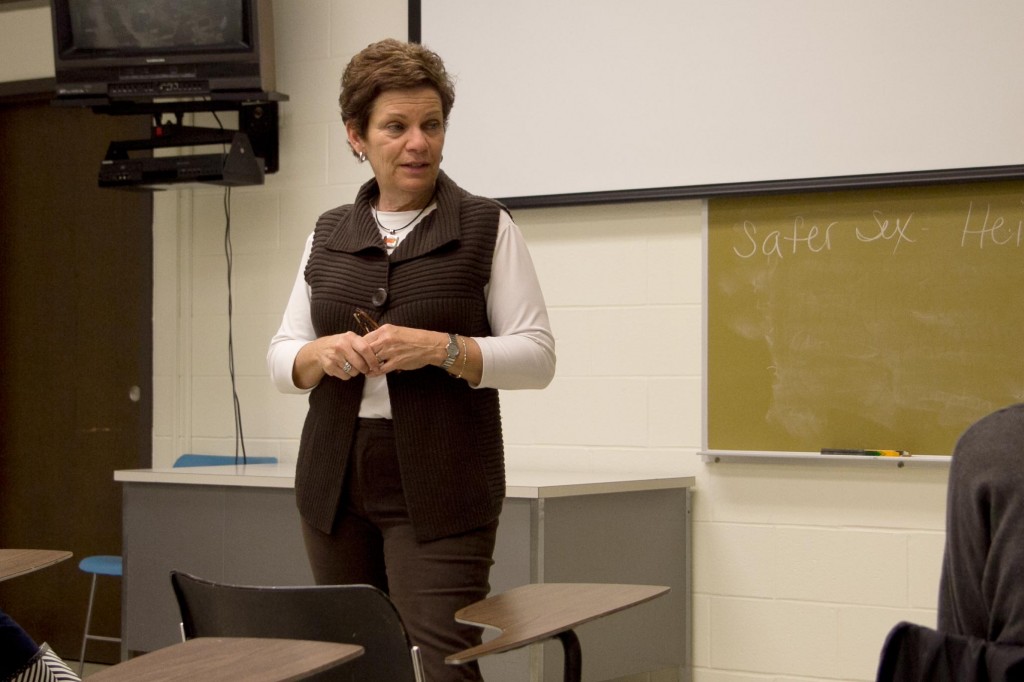
The health and wellness studies department began a series of health-related lectures on Friday with a seminar titled “Reducing the Risk… Safer Sex.”
Friday’s lecture was directed by Heidi Thirer, a lecturer who teaches Contemporary Health Issues and Human Sexuality for the health and wellness department.
During the seminar, she split the 15 students in attendance into three smaller groups and gave them each a scenario that would test the students’ knowledge of safer sex and spark conversation about the topic.
Thirer told students that sexual partners should discuss safer sex with frank, open conversation, even though it can be difficult.
“Discussing safer sex is embarrassing for people,” Thirer said. “Communication is a major barrier to safer sex.”
Ryan Stutts, a senior majoring in political science who attended the seminar, acknowledged the difficulty of talking about past sexual activity.
“[I]t’s all somewhat of a taboo subject so even when you are with someone you trust and are comfortable with communication can still be an issue,” Stutts wrote in an email.
Thirer had students discuss topics such as safe condom use, the rhythm method and the morning-after pill, and talked about different types of condom materials, menstruation and ovulation and the proper use of the Plan B pill.
“The ‘morning-after pill’ is misleading,” Thirer said. “You do have up to five days to take it, though it’s way more effective when taken earlier.”
Thirer also talked about the pros and cons of different condom materials. Latex condoms are effective at preventing bacterial and viral infections that can be passed by fluids, but are not safe for people with latex allergies and sensitivities, according to Thirer.
Sheepskin, or natural skin, is a good alternative to latex, but the pores of the condom are too large to fully protect against viruses like Hepatitis B and C and HIV. Polyurethane condoms prevent the spread of viral infections, however they are “not so snug” and could come off. Polyisoprene, a relatively new material, solves the issue of fitting better and is more stretchy, but is expensive.
However, Thirer said that condoms are not a cure-all solution to practicing safer sex.
“I think there is a misconception that condoms will prevent all STDs,” Thirer wrote in an email. “When used properly, condoms are very effective in preventing STDs such as HIV, Hepatitis B and C, Chlamydia and Gonorrhea. The concern is that the STDs that are transmitted from skin to skin contact (herpes and HPV) can still be transmitted even when using a condom.”
Thirer also spoke about the biological process occurring during menstruation. She said that ovulation occurs 14 days before a woman begins to menstruate. She also mentioned that sperm can live in the body for up to five days, and said that unprotected intercourse is never safe regardless of the time of month.
“At the time a couple is having unprotected intercourse, she has no idea when she’s going to ovulate, she only knows after the fact,” Thirer said. “You just can’t take the risk.”
This information was new for many of the students in attendance, including Stutts.
“As a male, the menstrual cycle isn’t anything that I really learned about or spent any time talking about, so that entire portion was new to me,” Stutts wrote.
The main point of the was that while safety is important, guaranteed “safe sex” is impossible.
“There is no real safe sex,” Thirer said. “You can reduce the risk, but not eliminate it.”
Thirer said she hoped to educate and inform students about the risks of STDs and pregnancy.
“When I talk about STDs, it’s not to scare you or ruin your sex life, that’s not my goal,” Thirer said. “My goal is to reduce the incidence of STDs and pregnancy on campus by giving people information.”
Thirer emphasized abstinence as another option for students to remain safe.
“I also believe strongly that as an educator and nurse, it’s important to remind students that abstaining from sexual relations is also a great choice and student’s should feel very positive about that decision,” she wrote. “They aren’t the only students who have decided to wait until they find their life long partner!”
She said that trust is a key element in relationships.
“I think relationships based on trust as the foundation are better than those that start with sex,” Thirer wrote.


